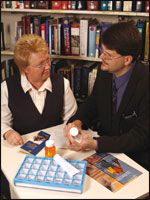Publication
Article
Pharmacy Careers
Mayo's Diversity of Practice Appealing to Pharmacists
Author(s):
Staff Writer

The Mayo Clinic is world-renownedfor itspatient care, integrated clinical practice, education, andresearch. For graduating pharmacy students, the MayoClinic can lead to a rewarding career as part of a healthcare team that is focused on putting the patients' needsfirst.
Known as the first and largest integrated, not-for-profitgroup practice in the world, the Mayo Clinic was named"Best Hospital" for the 19th consecutive year in the U.S.News & World Report 2008 America'sBest Hospitals issue. The publicationalso again named the health systemto its honor roll of top hospitals. Tomake the honor roll, a medical centerhas to rank at or near the top in at least6 of the 16 specialties included in therankings. The Mayo Clinic scored inthe top 5 in 12 specialties and rankedfirst or second in 7 specialties.
The Mayo Clinic has 3 locations inRochester, Minnesota; Scottsdale, Arizona;and Jacksonville, Florida, as wellas 17 hospitals in the Mayo HealthSystem in Iowa, Minnesota, andWisconsin.
Pharmacists can choose a career ininpatient or outpatient pharmacy—both areas offer opportunities for advancement withinthe Mayo family. The outpatient pharmacy in Rochesterfills 20,000 prescriptions a week and has 150 employees,explained Harlan Langstraat, RPh, vice chair, MedicalProducts, Mayo Clinic Health Solutions. Langstraat hasworked in the Rochester location for 9 years.
The outpatient pharmacy hires a significant numberof new pharmacists eachyear. In addition to atraditionalpharmacistposition,pharmacists canwork in medicationtherapymanagement (MTM),specialty pharmacy services,and research. Pharmacists also can work in 2 pharmaciesthat do not stock medications or fill prescriptions.Instead, the pharmacist's primary role is counselingpatients, according to Langstraat.
"It is a wonderful place for young pharmacists, becauseit offers such diverse practices and so many areas they cangravitate toward," he said.
In his experience, Langstraat is seeing incoming pharmacistsfocused on clinical pharmacy services, which isa reflection of the education they arereceiving today. Graduating pharmacistsare doing more with MTM, clinical,and specialty pharmacy services."We are fortunate in that we can offerthese services," he said.
The advantages of working at theMayo Clinic are numerous. Langstraatgoes back again to diversity of practice."A pharmacist over time can work inmany different positions. It is a wonderfulenvironment with true collaborationwith clinical departments. TheMayo Clinic also has world-class facilities,focuses on the needs of patients,and is on the cutting edge with itsinvolvement in clinical trials."
In terms of employment, Langstraatsaid that, because of the shortage of pharmacists, "we canbe selective with the candidates we hire." The criteria theylook for in potential pharmacy graduates include high-qualityclerkships and their experience during summerswith advancing their knowledge of pharmacy. He pointsout that Mayo hires from different pharmacy schools.Every year, the Mayo Clinic recruits at 15 pharmacyschools with a number inthe Midwest. New pharmacistsare trained in a traditionalpharmacy setting,and the remaining trainingis in areas in which they aregoing to work.
The Mayo Clinic Pharmacy offers a variety of 5-weekclerkship programs to students in their final year ofpharmacy school. Individuals completing the ambulatorycare rotation will further develop their skills in providingMTM to a variety of patients. The pharmacy managementrotation is designed to expose the student to issues affectingpharmacy management, and the pharmacy researchrotation allows the student to explore the pharmacist'srole in outpatient dispensing of investigational medication.
In terms of internships, "We focus on getting studentsfrom different colleges of pharmacy. The experience is notonly valuable to them, but valuable to our staff. Internscome from across the country and a high percentagemove on to residency programs," explained Langstraat.The internship is a salaried 12-week program. Pharmacistexperiences will include patient counseling, compounding,interacting with health care practitioners, and minirotations to acquaint pharmacists with specialty practiceswithin the pharmacy.
He said that a misconception about the Mayo Clinic isthat many pharmacists think they need a residency programfor employment consideration. Although the MayoClinic likes to hire individuals with a residency, it is nota requirement.
The Mayo Clinic offers opportunities for advancement.Langstraat said pharmacists interested in moving up theranks need to endorse the philosophy of the Mayo Clinic,exert and assert themselves—for example, take internaleducation classes offered and demonstrate leadershipthrough active involvement in state and local pharmacistassociations.
Langstraat has advice for graduating pharmacists."They need to think real hard about what they want fromthe practice of pharmacy. They need to ask themselveswhat they would like to be doing in 5 or 6 years. Manywill respond that they do not know until they gain moreexperience. I tell them to consider a career at the MayoClinic because of the diversity of pharmacy practice."

Pharmacists interested in pursuing a career in the inpatientpharmacy will not find a shortage of opportunities.
"I enjoy the challenges of the position and strategicallypositioning pharmacists so the pharmacy department isstructured to meet the Mayo Clinic mission," said KevinDillon, PharmD, director of pharmacy services in Rochester,on why he loves his job.
For Lance Oyen, PharmD, assistant director of pharmacyservices in Rochester, "It is the bright, innovativepeople you work with throughout the hospital. It is ateam atmosphere."
Graduating pharmacists will start in the central pharmacy,which provides a strong foundation to help pharmacistsbuild their pharmacy practice. Dr. Oyen said theyconsider candidates new to hospital pharmacy and pharmacygraduates with or without residency experience.
"I was a new graduate without residency experience,"explained Dr. Oyen. He completed a residency programafter 5 years with the Mayo Clinic. In his 16 years with themedical center, he has held 7 positions. "I have not eventouched upon all the opportunities."
The Mayo Clinic offers residency programs in pharmacotherapy,ambulatory care, critical care, infectiousdisease, oncology, and pediatrics. It also offers a HospitalPharmacy Internship and Clinic Outpatient PharmacyClerkship. The 12-week salaried internship programprovides in-depth exposure to inpatient pharmaceuticalservices to help pharmacists explore hospital pharmacyas a career. Pharmacist experiences include unit dosing,intravenous dispensing, and several mini rotations toacquaint pharmacists with specialty practices within ahospital pharmacy. The clerkship program runs 10 to 15weeks and will help pharmacy students further developtheir skills with a variety of patients.
A career in inpatient pharmacy offers opportunities foradvancement. "We encourage pharmacists to apply foreligible positions. The qualities we look for are pharmacists'personal goals, ability to work well with others, andinterest in management-type tracts," said Dr. Dillon.
Drs. Dillon and Oyen agree that the role of an inpatienthospital pharmacist has changed. "There is growingresponsibility to make sure patient care is safe, and pharmacistsare becoming more actively engaged in patientcare," said Dr. Dillon. Dr. Oyen sees a "pull toward thenondispensing aspect of pharmacy. The pharmacy professionhas moved toward comprehensive clinical care incollaboration with physicians and nurses."
In their combined years of experience, Drs. Dillon andOyen's advice for graduating pharmacy students is plentiful."Look at a place where you would want care or afamily member to receive care," said Dr. Oyen.
"Do not forget why you became a pharmacist," said Dr.Dillon. "Seek out a high-quality organization that is consistentwith your philosophy, and seek out a pharmacydepartment that is progressive and centered."







